How do you find out the times of trains when you are planning a journey?
I’d guess that like me and most other travellers, you go online and check them on the web or using an app. Like so many aspects of life, electronic devices like smartphones, tablets and PCs have had a huge impact on how we plan our travel and buy tickets. Your ticket may not even be a physical item anymore, with e-ticketing becoming increasingly common, but the paper or card ticket probably does still has a bit of life left in it yet.
However, technology has contributed towards the end of a publication with 180 years of history behind it—the printed version of the National Rail Timetable.
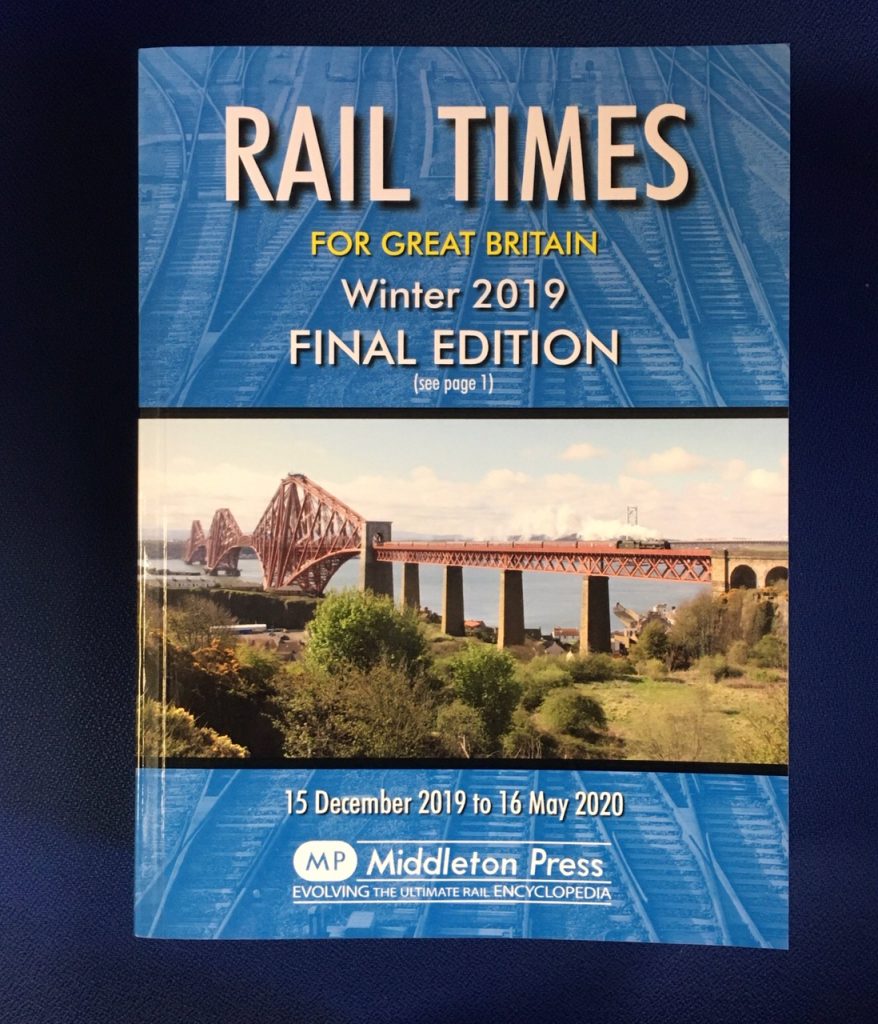
Most rail travellers nowadays will never have purchased or used one, but the last ever printed edition has just been published by Middleton Press for the current December 2019 – May 2020 timetable. This large tome comprises well over 1,000 pages and weighs in at 2kg so isn’t exactly pocket-sized, but is the equivalent volume to the first combined “national” timetables first produced by George Bradshaw in 1839.

In fact his first ever timetables published in October 1839 were produced in two separate issues, for northern and southern railway companies, but they were soon combined into the Bradshaw’s Railway Companion which by 1842 had been joined by Bradshaw’s Monthly Railway and Steam Navigation Guide, price 6d (about £2.80 today).
As the railway network spread with hundreds of new railway lines, many operated by different companies, “Bradshaw’s” quickly became a household name and an essential item for any regular long-distance traveller. They were initially reasonably pocket-sized, but by the end of the 19th century it had expanded to nearly 1000 pages, so you required a rather large pocket!
The grouping of the railway companies in 1923 into four large companies should have reduced the need for Bradshaw’s as all the companies produced their own combined public timetables for their respective lines (all, with the exception of the GWR using Bradshaw’s publisher Henry Blacklock & Co to print theirs). However, the appeal of a complete national timetable remained, and Bradshaw’s continued publishing 1961 after nearly 1500 editions.
Why did Bradshaw’s cease? British Rail only produced combined timetables for each of their six regions and initially they mainly used Blacklocks to print them but they gradually moved to other printers. With the price of a Bradshaw’s Guide at 12s 6d (the equivalent today of around £13) and the individual regional BR timetables being available to purchase at just one shilling each, the Bradshaw’s Guide became unviable for the publisher. The last edition was May 1961.
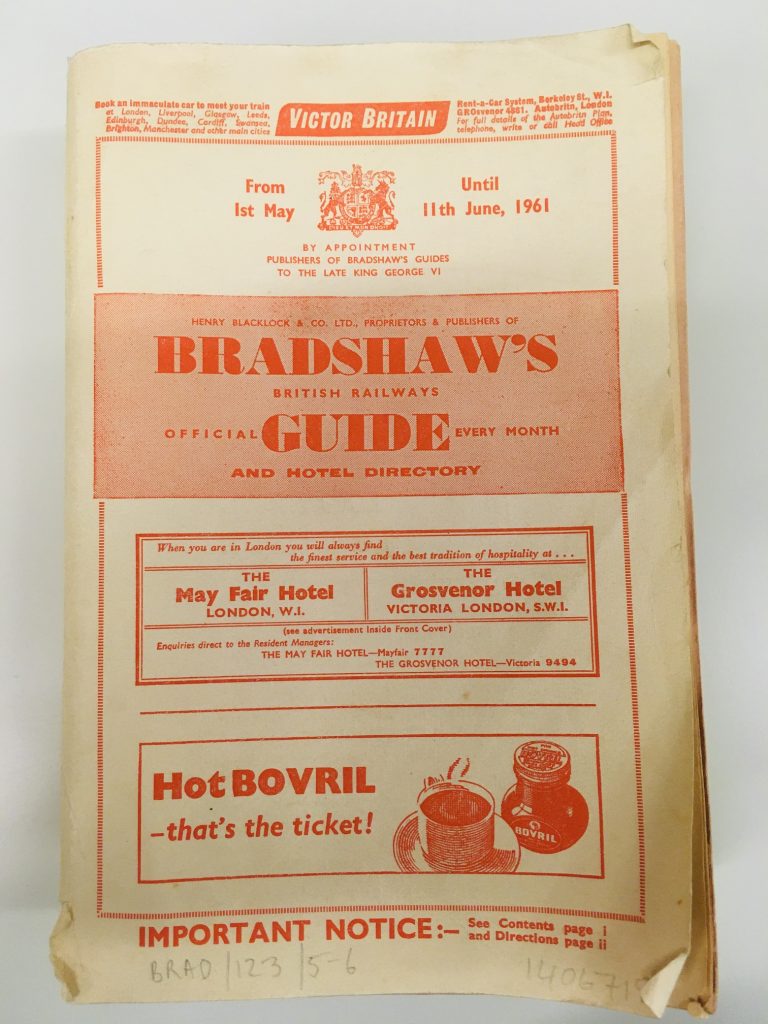
Remarkably, that marked the last published national timetable for nearly 13 years. BR continued to publish its regional timetables, and there was still the ABC Rail Guide. The ABC Guide was a long-standing competitor to Bradshaw’s that had started in 1853, but only provided times of trains to and from London and was arranged alphabetically so couldn’t be described as a full national timetable. BR did have plans to issue its own timetable in 1962 but it didn’t happen (I wonder whether the appointment of Richard Beeching as Chairman of BR and the subsequent planned closure of secondary and branch lines in the 1960s might have had an influence on this decision) and it wasn’t until 1974 that the first BR “all-system” timetable was issued.
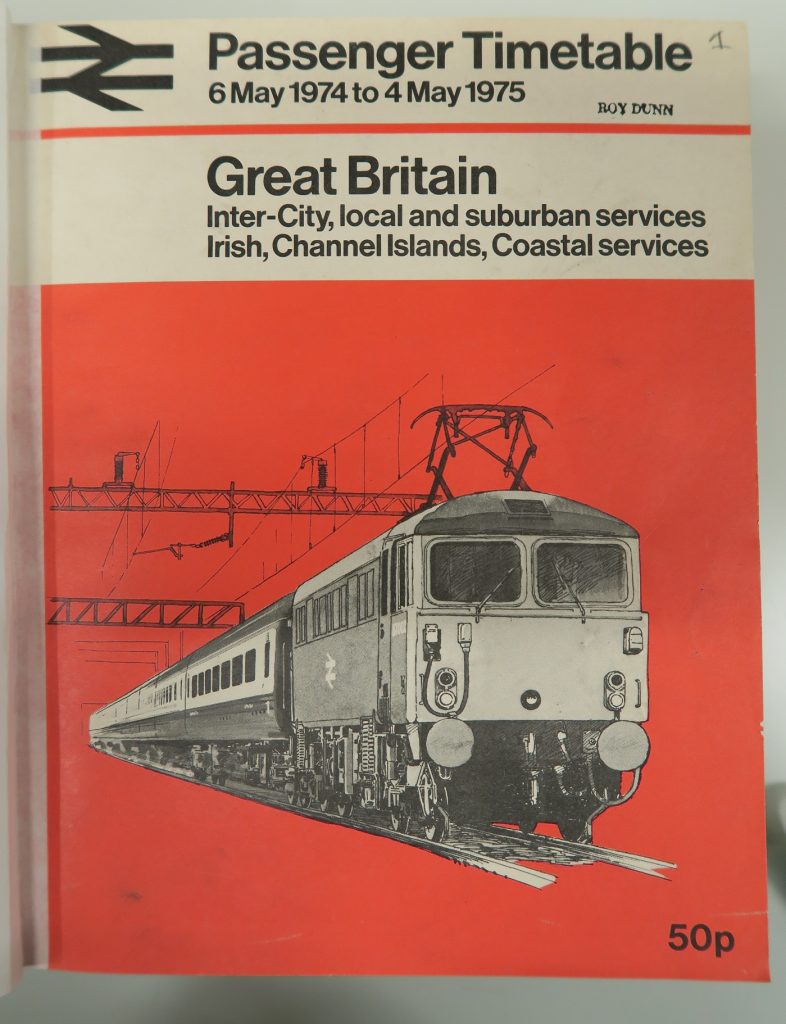
At a price of 50p (The equivalent of £10 now) it’s 1,350 pages provided times for the entire year. In 1986, BR started to issue the timetable twice a year, with summer and winter editions. At this time, it was something that BR wanted to publicise—even promoting its availability using posters like this striking example of graphic design based on the BR double arrow symbol.

It is around this point that my own memories of using the all system timetable began. During the late 1980s and early 1990s I would sometimes travel around the country using a rail rover ticket and the purchase of the national timetable was an essential accessory (and readily purchased from station bookstalls) and in the days long before the advent of the smartphone, a copy in my rucksack was really the only way to plan alternative routes and check connection times on the go.
Privatisation during the 1990s didn’t have an immediate effect, but it was technology that was to eventually hasten demise of the timetable. In December 2006, Network Rail first made the timetable freely available on their website. In May 2007 the last printed edition was produced “as demand has declined over recent years to the point where it is uneconomical to print”.
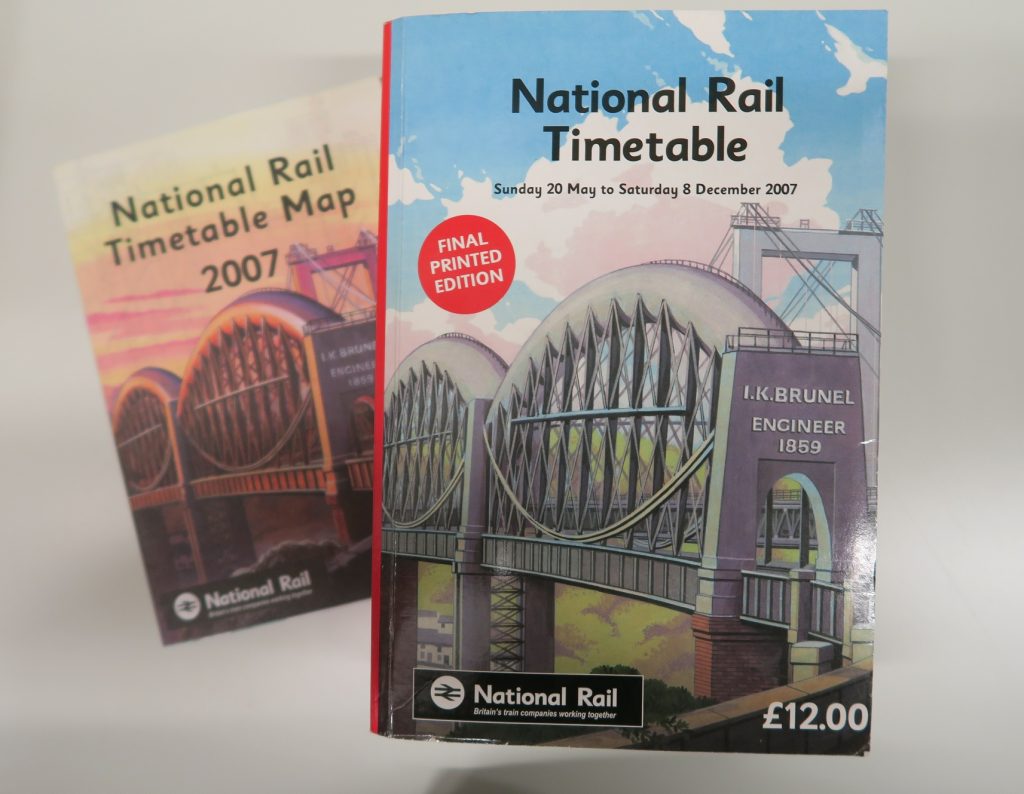
That could have been the end, but the timetable was made freely available for anyone to use or print and that enabled other commercial publishers to publish under licence. For a number of years The Stationery Office (TSO) and Middleton Press continued the tradition, but a few years ago TSO ceased publication and only Middleton remained.
Various factors, including the ability to freely download a digital version, the price of the printed version increasing to £26, more services leading to an ever larger timetable making it unwieldy to carry around all possibly combined to declining sales which finally appear to have brought an end to this long tradition.
Network Rail will continue to publish the electronic timetable available on its website, however it is hard not to be a little saddened by the passing of the printed volume. I often find browsing pages in a book to be somehow more satisfying and user-friendly than viewing the same information on a screen.
One advantage of the advent of digital-only information is that it does mean we don’t have to find additional space in our archives to accommodate physical items, as every year the timetable was occupying an extra archive box. We do also continue to collect the digital versions, along with those for the Network Rail working timetable (which moved to digital-only some years ago) and will continue to make them accessible for researchers here in Search Engine, our library and archive centre.
If you want to delve deeper into our historic timetable collection, you can find out how by visiting our website.
www.railwaymuseum.org.uk/research-and-archive
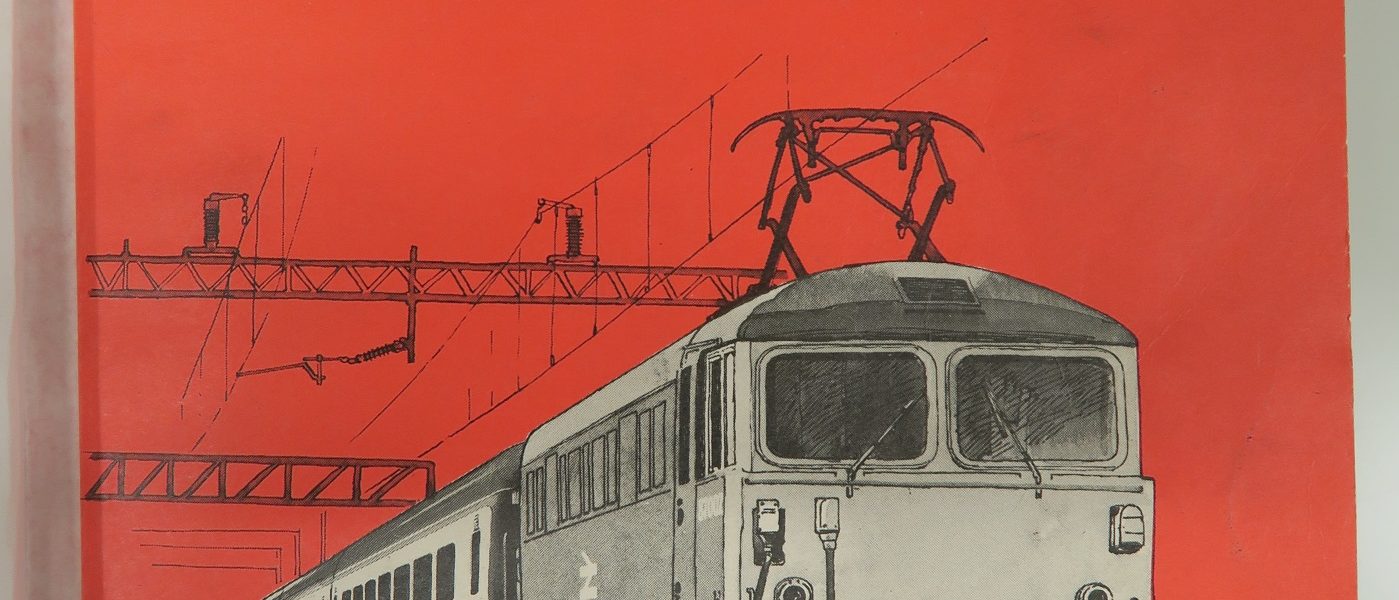
I still have several copies of regional timetables (mainly NE Region): Summer 1961; Winter 1962-63; Summer 1963; Winter 1965-66; Summer 1967; Winter 1967-68; as well as: London Midland Region Summer 1963; Scottish Region, Summer 1963 and Eastern Region, Summer 1963 from which I scanned various pages for ‘Named Expresses’ for David Hey. It’s great to thumb through and compare timings then and now.
If you haven’t already discovered David hey’s Collection then I urge you to do so now:
http://www.davidheyscollection.com/
My National Rail Timetable Map (2007) is now a bit careworn and dog-eared,
is it possible to get a replacement?
Yes i can help – Take a look at my website – Transport Past Times
I have a spare one very good condition
Interesting – I was not aware that the 1974-75 National Railway Timetable was the first national issue since the demise of Bradshaw. Because I had a copy of the final Bradshaw I purchased the last BR edition and therefore in effect have a ‘full set’ as well as a reprint of the 1839 Bradshaw.
I started collecting timetables when I was a pupil in the early 80s. Printed timetables have always been a part of holidays and journeys by train. Today I can repeat the journeys in mind when I flick through the pages of the heavy books….
The trains appear in mind, situations become alive which are already history for a long while, rusted tracks become shiny again when I see the old local track maps inside…..memories, lovely memories…
It was a shame when in 2008 German Rail (Deutsche Bahn) ceased printing the timetable book (Kursbuch) and I was happy when travelling to the UK to get printed versions. Now this era has come to an end as well. I will keep them safe beside my german, swiss, belgian, hungarian….timetables.
PDF and mobile phones replaced printed timetables, bits and bytes disappear after timetable changes, but paper will persist in the cabinet. Poor times – not just for the railway….
Greetings from Germany
There were also ‘internal’ BR versions of the full timetable for use in travel centres and TEB for ‘heavy use’ in three A4 sized binders, although most ticket offices had the ‘public’ A5 sized version. From the early 1990’s the timetables were computerised.
I used to sit in the library in my home town and flick through the pages and also bought the national rail timetables in the 1980s from when I left school, at a time also when they were very large volumes which had the right size font and point size that could easily be read without eye strain, but the volumes shrunk in size, with a smaller font size. Not sure why, but I think it was for creating more space, when Mum was having a massive clearing out, we ended up dumping the volumes, I must have been asked if I wanted to keep the books which I said no to without much thought, I kept the maps though. I even got rid of the shrunk down volumes. I do remember though, spending hours plotting national rail tours around the country from all four corners of the UK, even when I didn’t do much travelling at the time physically, writing down the times of departing and connecting trains, apart from when I used to do the East Midland Rover Tours not long after I had left school.